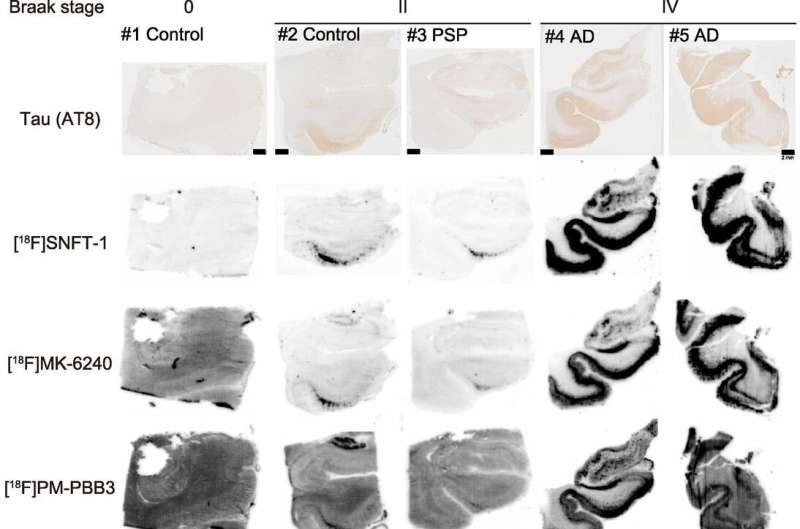This article has been reviewed according to Science X's editorial process and policies. Editors have highlighted the following attributes while ensuring the content's credibility:
fact-checked
peer-reviewed publication
trusted source
proofread
Novel tau PET tracer exhibits high sensitivity and specificity, allows earlier identification of Alzheimer's disease

A new tau PET radiotracer, 18F-SNFT-1, has been found to be more effective than existing tau PET radiotracers in identifying Alzheimer's disease in its earliest stages, according to research published in the September issue of the Journal of Nuclear Medicine.
In a head-to-head comparison, 18F-SNFT-1 possessed preferable brain pharmacokinetics and demonstrated higher affinity and selectivity for Alzheimer's tau lesions compared to clinically used second-generation tau PET tracers.
Tau lesions are the neuropathologic hallmarks of Alzheimer's disease, and tau accumulation is closely associated with future cognitive decline. PET imaging with specific tau radiotracers provides information on the progression of the tau burden, which can help to assess disease activity, determine treatment, and predict therapeutic outcomes.
"Much effort over the past decade has been focused on generating PET radiotracers to visualize tau lesions in vivo," said Nobuyuki Okamura, MD, Ph.D., professor of Division of Pharmacology, Faculty of Medicine at Tohoku Medical and Pharmaceutical University in Sendai, Japan.
"While progress has been made, existing tau PET radiotracers have problems with insufficient sensitivity to early lesions and the presence of off-target binding. To address these issues, our research team created an optimized tau PET tracer, 18F-SNFT-1, with high sensitivity and specificity to tau pathology in Alzheimer's disease."
In the study, researchers compared the binding profile of 18F-SNFT-1 with those of other reported tau PET radiotracers.
In vitro binding properties of 18F-labeled tau tracers were evaluated through the autoradiography of frozen human brain tissues from patients with diverse neurodegenerative diseases. Pharmacokinetics, metabolism, and radiation dosimetry were assessed in normal mice after intravenous administration of 18F-SNFT-1.
In vitro binding assays demonstrated that 18F-SNFT-1 possesses high selectivity and high affinity for tau lesions in the brain tissue of patients with Alzheimer's disease.
Autoradiographic analysis of tau deposits in medial temporal brain sections from patients with Alzheimer's disease showed a higher signal-to-background ratio for 18F-SNFT-1 than for the other tau PET tracers and no significant off-target binding. 18F-SNFT-1 also showed a high initial brain uptake and rapid washout from the brains of normal mice without radiolabeled metabolites.
"Therapeutic agents targeting tau protein are under development, and treatment with anti-tau drugs should be initiated as early as possible," said Okamura. "Early detection of tau lesions using 18F-SNFT-1 may accelerate the initiation of therapy with anti-tau drugs and improve the lives of people with Alzheimer's disease."
More information: Ryuichi Harada et al, Preclinical Characterization of the Tau PET Tracer [18F]SNFT-1: Comparison of Tau PET Tracers, Journal of Nuclear Medicine (2023). DOI: 10.2967/jnumed.123.265593



















